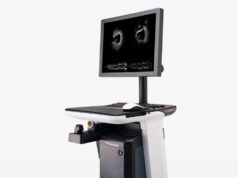
By Sachin Goel and Samir Kapadia
Outcomes of percutaneous coronary intervention in patients with severe aortic stenosis and coronary artery disease have remained understudied. This is because surgical aortic valve replacement and concomitant coronary artery bypass grafting have been the main treatment for severe aortic stenosis and coronary artery disease until recently.
Transcatheter aortic valve implantation (TAVI) has emerged as a feasible treatment option for patients with severe aortic stenosis who are at high risk with conventional surgical aortic valve replacement. Over 30,000 TAVIs have been performed worldwide, however, there is no consensus regarding the management of significant coronary artery disease in this setting. Occasionally, high-risk patients with severe aortic stenosis undergo percutaneous coronary intervention when there are contraindications to surgery or when their symptoms are felt to be attributable to a significant degree to coronary artery disease. We recently reported our experience with percutaneous coronary intervention in patients with severe aortic stenosis.
We studied the short-term outcomes of 254 patients with severe aortic stenosis who underwent percutaneous coronary intervention at the Cleveland Clinic over 11 years, and compared these with a propensity matched group of 508 patients derived from a pool of 20,069 patients without aortic stenosis who underwent percutaneous coronary intervention during the same time period. The mean age was 75 years in both groups, and patients with severe aortic stenosis had a mean STS score of 13 with 38% of patients with an STS score ≥10. The indications for percutaneous coronary intervention in patients with severe aortic stenosis were: acute coronary syndrome (unstable angina in 41%, NSTEMI in 19%, STEMI in 6%), stable angina in 24% and progressive NYHA class III/IV heart failure in 43% patients when the symptoms were felt to be more attributable to coronary artery disease or these patients were deemed high risk for surgical aortic valve replacement. We found no difference in 30 day mortality post percutaneous coronary intervention in patients with and without severe aortic stenosis (4.3% versus 4.7%). In a subgroup analysis, patients with low ejection fraction (≤30%) had a high 30 day post percutaneous coronary intervention mortality of 15.4% compared to 1.2% in patients with ejection fraction >30%.
Additionally, patients with severe aortic stenosis and high STS score (≥10) had a higher 30 day post percutaneous coronary intervention mortality of 10.4% compared to no mortality in those with STS score <10. The majority of 30 day deaths in patients with aortic stenosis who underwent percutaneous coronary intervention were related to progressive cardiac and multiorgan failure. Complication rates of percutaneous coronary intervention were similar in patients with and without aortic stenosis.
The main take-home message of this study is that percutaneous coronary intervention can be performed in patients with severe aortic stenosis and coronary artery disease without an increase in short-term mortality or procedural complications compared to propensity matched patients without aortic stenosis, particularly in those with preserved ejection fraction or absence of comorbidities. Severe aortic stenosis patients with low ejection fraction and comorbidities should be considered as high-risk candidates for percutaneous coronary intervention. Further research is needed to identify which patients require revascularisation prior to TAVI and the timing of revascularisation. Our study indicates that if percutaneous coronary intervention is undertaken in these high-risk aortic stenosis patients, they should not wait for a long time without undergoing a definitive procedure for their aortic stenosis i.e. TAVI.
Sachin Goel is clinical associate, Department of Cardiovascular Medicine, Cleveland Clinic Foundation, USA.
Samir Kapadia is professor of Medicine and director, Sones Cardiac Catheterization Laboratories, Cleveland Clinic Foundation, USA.











